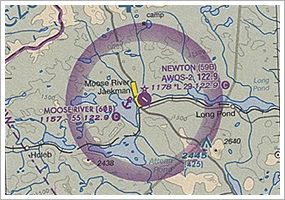Custom content for the Sept. 24, 2010, issue of 'AOPA ePilot' newsletter
| The following stories from the September 24, 2010, edition of AOPA ePilot were provided to AOPA members who expressed an interest in the particular subject areas. Any AOPA member can receive information tailored to their areas of interest by updating their preferences online. |
training tipsRemote airports The Sept. 17 “ Training Tip: Destination weather” urged pilots to cast a wide weather net when flying to a destination that has no on-field observations. Related considerations when flying to out-of-the-way places are limited communications and aircraft services. Over uniform or sparsely populated terrain there may be few good visual checkpoints for navigation. An example of a remote airfield is Newton Field, an unattended airport in mountainous Jackman, Maine. According to its listing in AOPA Airports, the rotating beacon is out of service and runway markings are faded. Comments from a pilot who used the airport provided some nice-to-know details: “Nice little strip with automated self-serve fuel, bathroom and phone to call FSS (no cell service around there). Tie-down rings are there, but bring your own ropes and chocks.” That’s the situation on the ground. Airborne radio communications may be limited in remote areas too. So it’s important to check for any remote communications outlets during flight planning. “When you find yourself in the middle of nowhere and in need of some current weather information, you can look at your chart and find an RCO, or remote communications outlet. These outlets serve flight service stations and allow you to contact a flight service specialist by relaying your signal through the outlet when distance or obstacles would make direct radio communication impossible,” Elizabeth Tennyson explained in the April 2001 Flight Training’s “ Aviation Speak.” When airports are few and far between, combine methods of VFR navigation such as pilotage and radio navigation to make it less likely that you’ll miss a visual checkpoint or have trouble spotting the airport. Such a flight makes filing and activating a VFR flight plan a great idea, too. Why? “Filing a flight plan is not required by regulations; however, it is a good operating practice, since the information contained in the flight plan can be used in search and rescue in the event of an emergency,” explains Chapter 15 of the Pilot’s Handbook of Aeronautical Knowledge. Test your safety sensibilities against this AOPA Air Safety Foundation safety quiz on emergency procedures—especially Question Five, which considers a forced landing in a remote area. Answering it correctly is a great indication that you’re good to go. training productsSmall headset/accessory bag from Pilotmall.comFlight bags are no longer one-size-fits-all. Depending on your needs, you can find nearly every size, shape, color, and fabric. And, if you’re looking for a smaller bag to tote a headset or two and a few accessories, Pilotmall.com has a well-constructed, economical entry ($24.99) for you to consider. The bag measures just 11.5 inches tall by 10 inches wide by 9 inches deep, comes with a detachable shoulder strap, and is made of 840 denier nylon. Note that this bag was to be included in the August 2010 Flight Training Gear Guide but missed the cut only because of a photo deadline. Order it online.
Note: Products listed have not been evaluated by ePilot editors unless otherwise noted. AOPA assumes no responsibility for products or services listed or for claims or actions by manufacturers or vendors. final exam
Question: When can I log night time for the purposes of meeting the requirements for getting a private pilot certificate?
Answer: Under 14 CFR 1.1, "night" is defined as the time between the end of evening civil twilight and the beginning of morning civil twilight, as published in the American Air Almanac, converted to local time. There is a calculator that can help you determine when civil twilight is, based on the date and your location. For more information on night regulations, read this article from AOPA Pilot.
Got a question for our technical services staff? E-mail [email protected] or call the Pilot Information Center, 800/872-2672. Don’t forget the online archive of “Final Exam” questions and answers, searchable by keyword or topic. |



